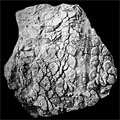The Echinoid Directory
Albertechinus Stearn, 1956, p. 741
| Diagnostic Features |
|
|---|---|
| Distribution | Upper Devonian, Alberta, Canada. |
| Name gender | masculine |
| Type | Albertechinus montanus Stearn, 1956, p. 744, by original designation. Holotype, Geological Survey of Canada, Ottawa 12770. |
| Species Included |
|
| Classification and/or Status |
|
| Remarks |
|


